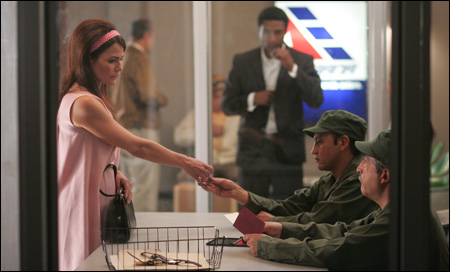Annual Wasserman Forum at MIT, Deb Todd Wheeler at Green Street, David Rees at Harvard
Early video art set itself apart from movie-theater cinema by its grainy insistence on real time and real actions, as opposed to the dramatic conventions and fictions of big-screen blockbusters. Bruce Nauman filmed himself walking funny through a slim corridor he built in his studio, Martha Rosler stood before a static camera in a suburban kitchen wielding knives and language to increasingly pointed effect, and William Wegman gave his dog a spelling lesson. Ostensibly banal moments with low production values and flimsy, if any, narrative, they were riveting.

Stan Douglas, Inconsolable Memories (2005)
|
Over the past 20 years, video art has expanded to take on the big emotions and visceral thrills of its cinematic relative, including multiple-screen projects and immersive spatial environments, trends pioneered by artists including Bill Viola in the 1970s and Diana Thater in the 1990s. This year’s annual Max Wasserman Forum on Contemporary Art at MIT takes on what can be seen as the two opposite extremes of video expression — static single camera and full-on cinema — in the panel discussion “A Matter of Time: Feedback and Immersion in Video Installation Art,” in MIT’s Auditorium 26-100 on November 14. Moderator (and SF-based curator) Christopher Eamon and panelists Stan Douglas, Thomas Y. Levin, and Diana Thater consider the varied approaches to video taken over the past three decades.
One thing that the most cutting-edge video technology shares with our little lives is its reliance on the plug and the outlet. We’re so thoroughly and invisibly driven by electricity that outages leave us powerless, stumbling in the dark without entertainment or hot water. A new exhibition at Green Street Gallery experiments with an alternate power source — human power — in “Deb Todd Wheeler: Live Experiments in Human Energy Exchange (endurable velocipede, version 3),” which is on view through December 14, with an opening reception on November 10. Visitors are encouraged to sign up as “Volunteer Energy Generators” — which means agreeing to pedal the modified bicycle that activates the kinetic sculptures on view, which include a windmill-and-pulley-powered cassette deck that plays the soundtrack from a video of the 1964 “Futurama,” a GM-sponsored exhibit at the 1964 New York World’s Fair. Billed as “part utopian fantasy, part meditation on possibilities and impossibilities in sustainability,” Todd Wheeler’s installation creates a colorful, interactive brush with the future. With a retro twist.
War may not be too funny, but artist and activist David Rees certainly is, and his comic strip “Get Your War On,” which has been running in publications like the
Village Voice
and on Rees’s Web site at www.mnftiu.cc since the US began Operation Enduring Freedom in Afghanistan in October 2001, is an enormous cult favorite. Rees comes to Harvard’s Sackler Museum on November 16 — you’ll laugh, you’ll cry, it’s free.
“A Matter of Time” at MIT Auditorium 26-100, 77 Mass Ave, Cambridge | November 14 at 6:30 pm | 617.253.4680 | “Deb Todd Wheeler” at Green Street Gallery, 141 Green St, Boston | through December 14; opening reception November 10: 7-9 pm | 617.522.0000 | David Rees on “Get Your War On” at Arthur M. Sackler Museum, 485 Broadway, Cambridge | November 16 at 6 pm | 617.495.9400
On the Web
MIT Auditorium: //web.mit.edu/vac
Green Street Gallery: //www.greenstreetgallery.org
Arthur M. Sackler Museum: //www.artmuseums.harvard.edu
David Rees's Web site: //www.mnftiu.cc